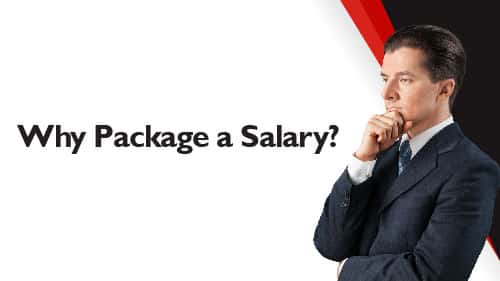Reportable fringe benefits and salary packaging are crucial aspects of employment that impact both employers and employees.
Understanding the rules and regulations surrounding these benefits is essential for ensuring compliance with tax laws and maximising the value of compensation packages.
In this article, we’ll delve into the key concepts of reportable fringe benefits and salary packaging and provide insights into what you need to know to navigate this area of Australian tax law.

What Is Salary Packaging?
Salary packaging is an arrangement where an employer provides a portion of the employee’s salary in non-cash benefits instead of a cash salary.
Fringe benefits include
- A company car
- Private health insurance
- Gym memberships
- Electronic devices
- Additional superannuation contributions

Why Package a Salary?
If you’re an employee, there are many beneficial reasons to package a salary, including
- Tax savings. Some benefits are taxed lower than cash salary, allowing you to reduce your taxable income and potentially pay less tax.
- Increased take-home pay. By lowering your taxable income, you may be able to increase your take-home pay.
- Access to goods and services. Salary packaging can provide access to goods and services you may not be able to afford otherwise, such as a car or private health insurance.
- Flexibility. You can customise your salary package to suit your needs and preferences.
If you’re an employer, salary packaging benefits include
- Attraction and retention. Offering attractive salary packaging options can help attract and retain talented employees.
- Reduced payroll tax. Some benefits are exempt from payroll tax, allowing for a reduction of your payroll tax liability.
- Increased employee satisfaction. Providing employees with access to desirable benefits can increase employee satisfaction and engagement.
- Group discounts. Negotiating group discounts on benefits such as health insurance and retirement plans is often possible, saving you and your employees money.

How Do I Package a Salary?
Packaging a salary for your employees involves several steps.
- Determine eligible benefits. Identify the fringe benefits suitable for packaging, as some benefits may not be eligible. Check the Australian Taxation Office (ATO) guidelines for eligibility.
- Consider tax implications. Some benefits may attract a higher tax rate than others.
- Agree on the package. You and your employees should agree on the benefits to be included in the salary package, taking into account your employees’ individual needs and preferences.
- Calculate the package value. Consider the cost of the benefits and any tax savings, as some benefits may be more expensive than others.
- Adjust your employee’s salary. You should adjust this to reflect the value of the salary package.
- Administer the package. You should administer the salary package, including arranging benefits and ensuring compliance with reporting and taxation requirements.
- Administration. Take enough time to ensure a smooth salary packaging administration, as some benefits may be more complex to administer than others.

What Are Some Common Forms of Salary Sacrifice?
As an employee, you can choose several common forms of salary sacrifice, all offering benefits while reducing your taxable income.
You can salary sacrifice a vehicle lease, providing access to a car without the upfront costs of purchasing one outright.
The lease payments are deducted from your pre-tax salary.
You may salary sacrifice a portion of your income into an investment account, such as a superannuation fund or shares.
Doing so can increase your long-term wealth.
Salary-sacrificing expenses such as mobile phone bills, internet, and home office expenses are another way to reduce your taxable income.
Sacrificing a portion of your income towards housing expenses, like rent or mortgage payments, can help ease the burden of living costs.
If you have children, you may sacrifice a portion of your income towards childcare expenses, which is also a considerable cost.
Your employer may offer you a low-interest loan, which you can repay through salary sacrifice arrangements.
This can provide you access to affordable credit.

Estimating Fringe Benefits
Estimating the value of fringe benefits is a vital aspect of salary packaging.
This value determines the pre-tax salary employers and employees involved in salary packaging can direct towards those fringe benefits.
The value of fringe benefits can be estimated using several methods.
The cost method involves estimating the cost of providing the fringe benefit, such as the cost of a leased vehicle or private health insurance.
This method is ideal for benefits that have a fixed price.
The statutory formula method requires using a formula provided by the ATO to estimate the value of the fringe benefit.
This method is standard primarily for benefits such as car fringe benefits, where the value of the benefit is calculated based on the car’s cost price and the number of days it’s available for private use.
The employee contribution method entails deducting any amount paid by the employee towards the cost of the fringe benefit from the total cost of providing the benefit.
The resulting amount is then used to calculate the taxable value of the benefit.
It’s important to note that the value of fringe benefits can impact an employee’s overall taxable income and, therefore, their tax liability.
You should consult with the ATO or a professional accountant to ensure you correctly estimate the value of fringe benefits and comply with tax laws.

Need Help Packaging a Salary With Fringe Benefits?
Still wondering, how does salary sacrifice work?
If you’re an employer or employee looking to combine salary packaging and reportable fringe benefits but need help figuring out where to start, Pherrus Financial Services is here for you.
Our team of experts can guide you through the process and provide tailored advice to help you maximise salary packaging benefits.
Fill in our online form, and we’ll contact you shortly.
Alternatively, call us to book an appointment at our Bella Vista office in Sydney, NSW.





